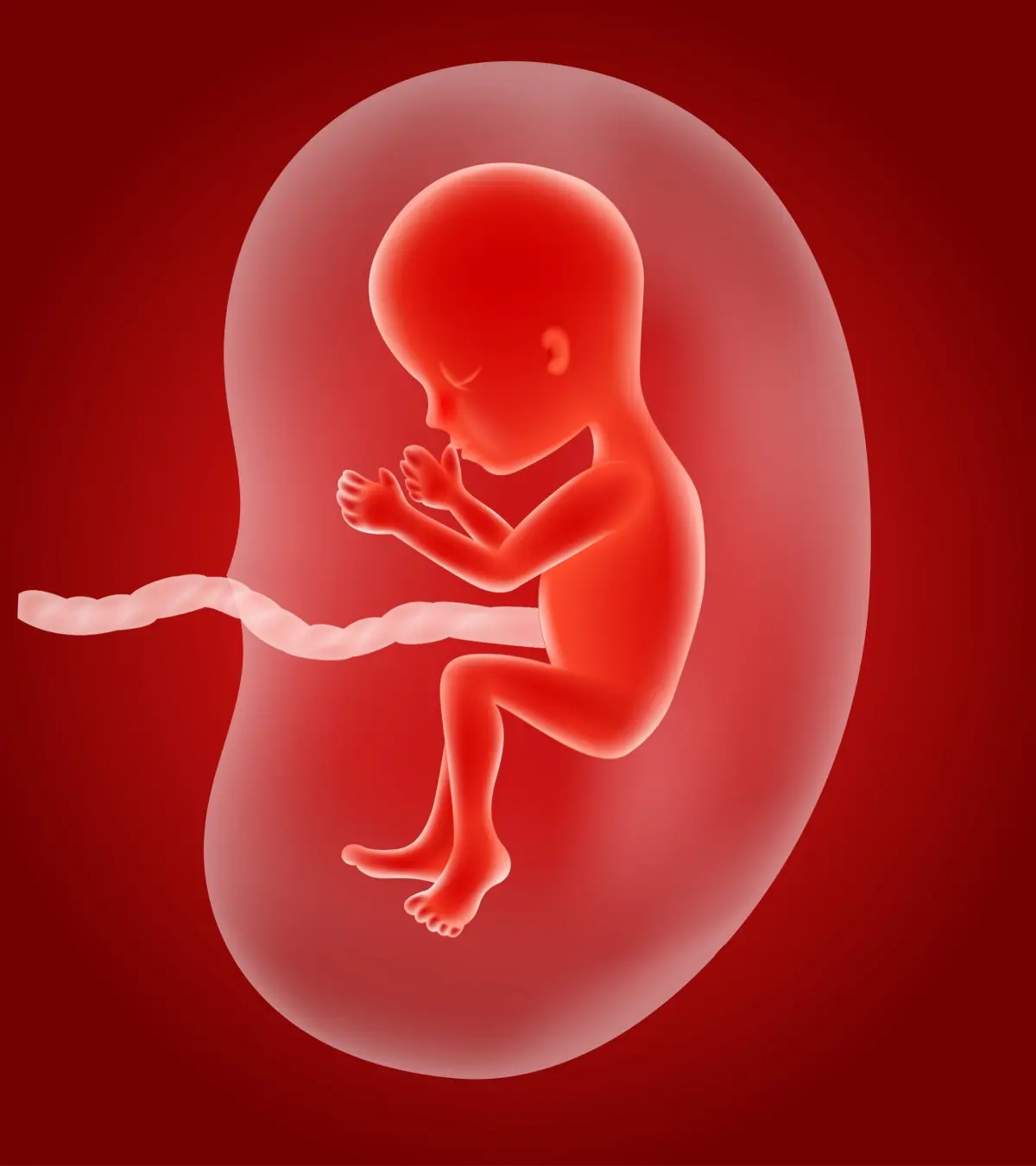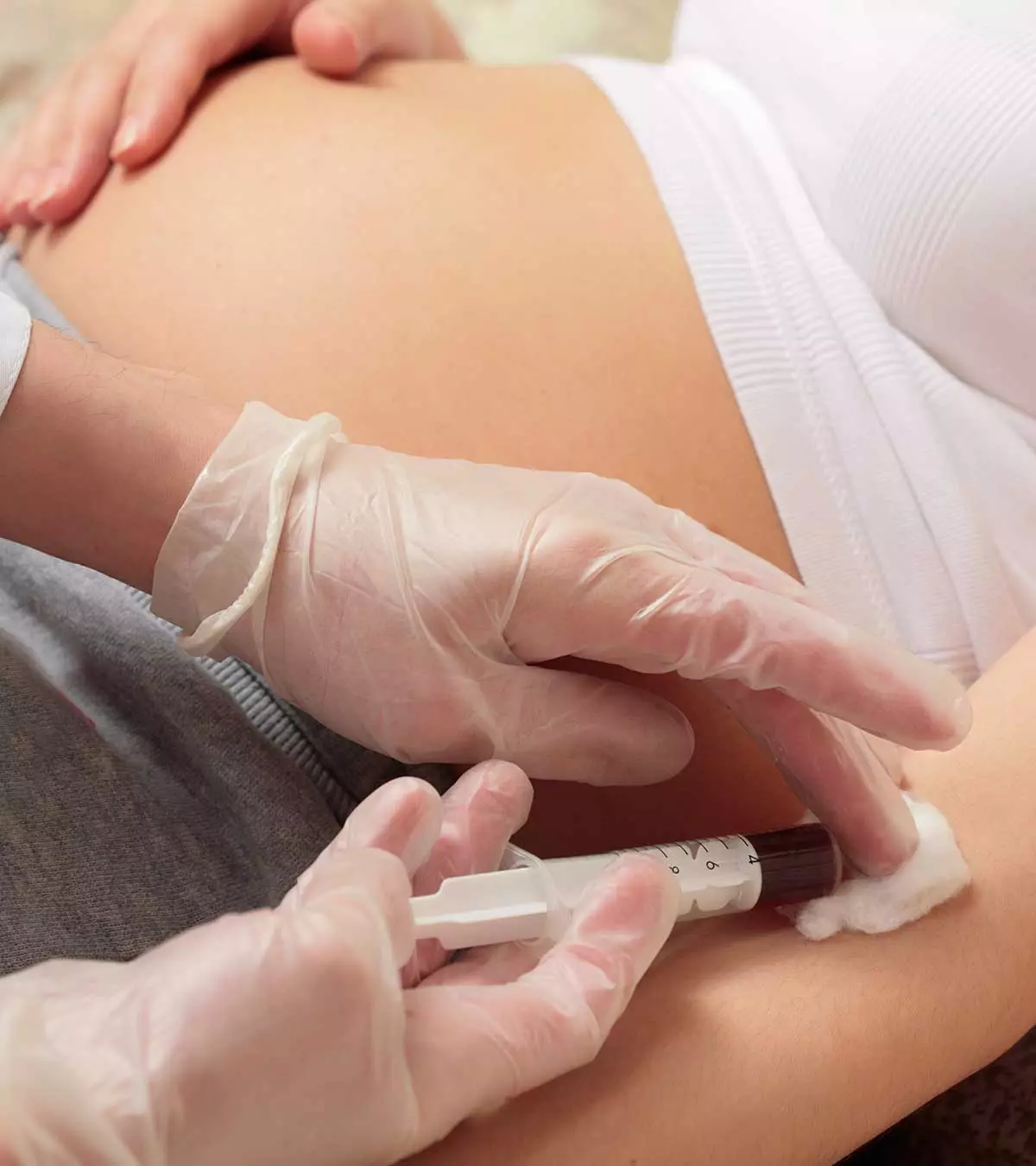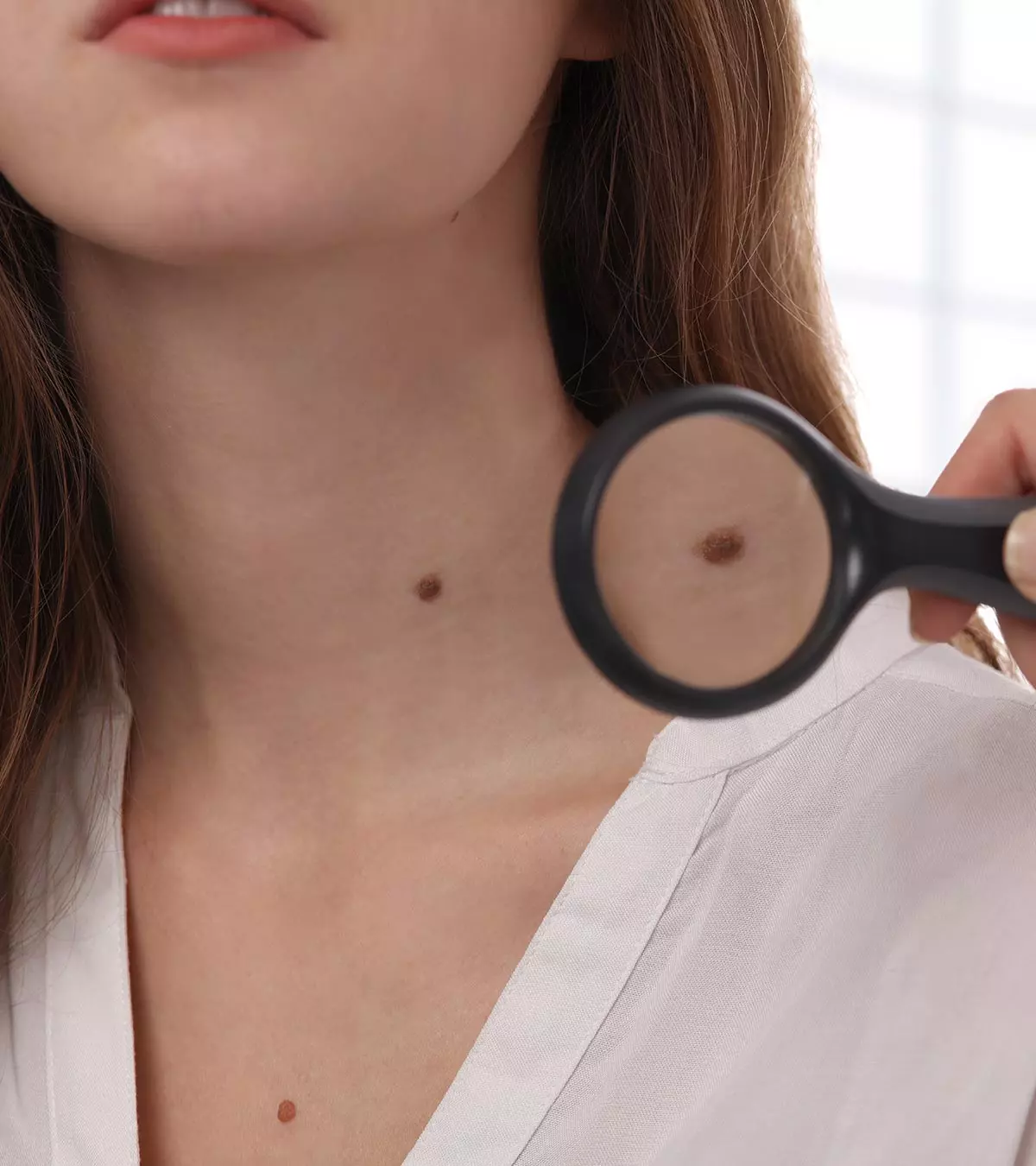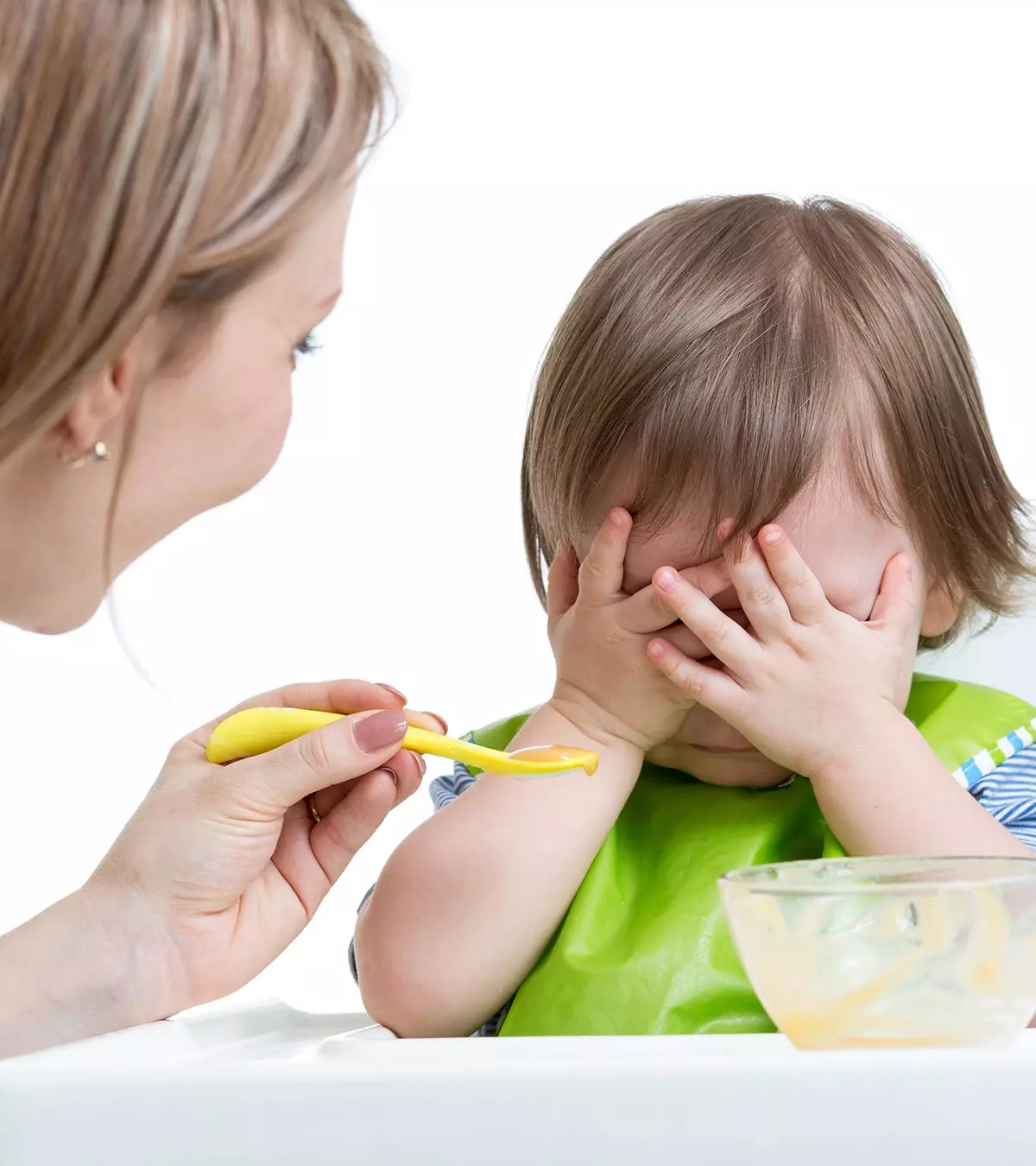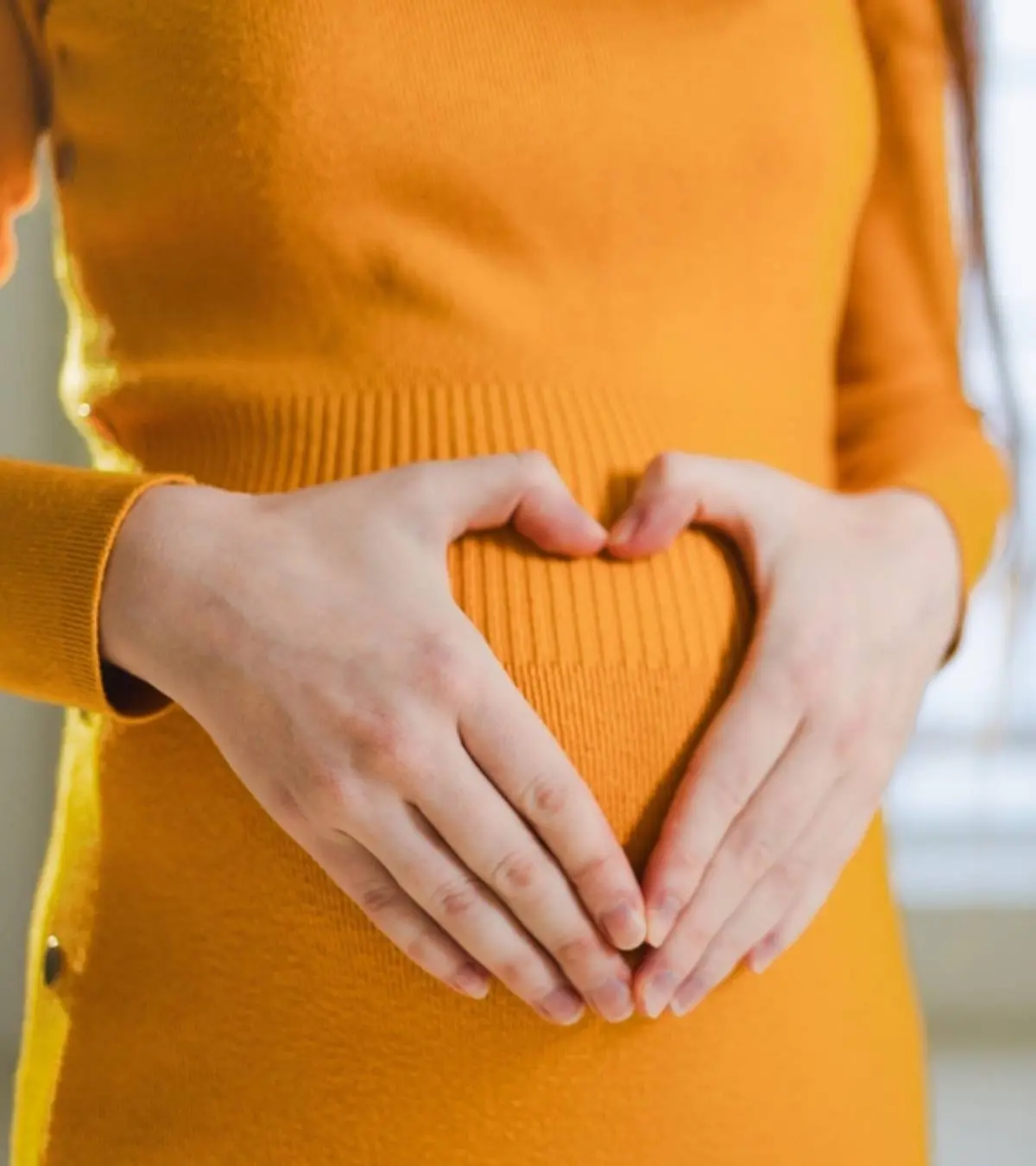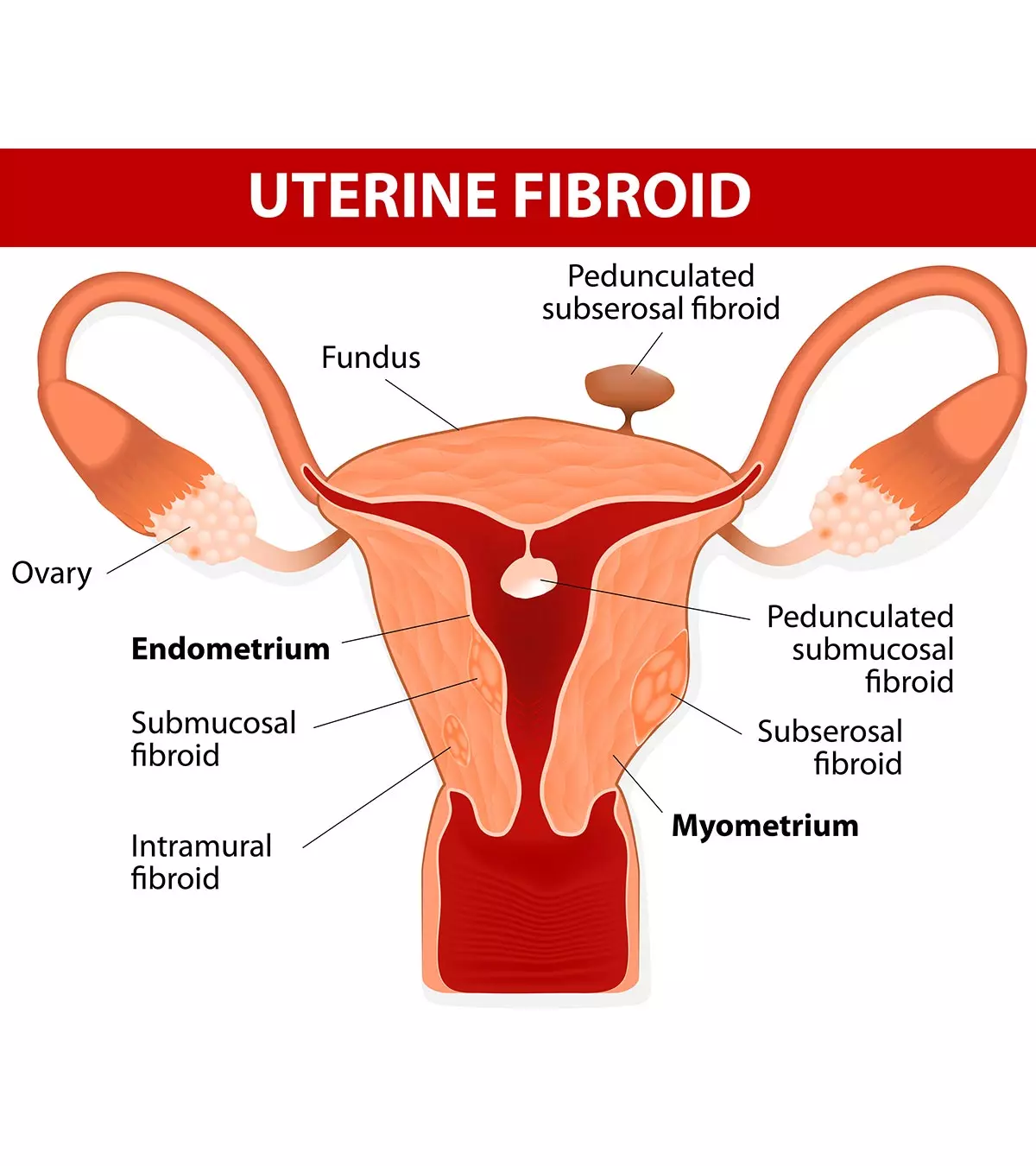
When pregnant, a woman could be exposed to many health conditions. For example, uterine fibroids during pregnancy is a common and benign condition that may affect reproductive health in many ways. According to the researchers, about 1.6 to 16.7% of all pregnant women are diagnosed with fibroids at different stages during pregnancy (1). However, a few studies have demonstrated that uterine fibroids could pose certain pregnancy risks in the first trimester. On the contrary, others suggest that uterine fibroids could increase the risk of a C-section. Altogether the size and location of the fibroid in the uterus are vital factors that determine if it might cause any obstetriciRelated to pregnancy, childbirth, and the postpartum period. complications. Keep reading to learn about the types, diagnoses, possible risks, and treatment of uterine fibroids during pregnancy.
Key Pointers
- Uterine fibroids are abnormal non-cancerous growths of fibrous tissues on the uterine wall.
- They are common in women in their mid-30s, particularly those who are overweight and not on birth control pills.
- Fibroid-associated complications include back and leg pain, cramps, vaginal bleeding, and pain while urinating during pregnancy.
- In most cases, fibroids do not pose a risk to the baby during pregnancy, but in some cases, they may increase the chances of a cesarean delivery.
- Hormone-balancing drugs or surgical methods are the typical courses of treatment for uterine fibroids.
What Are Uterine Fibroids?
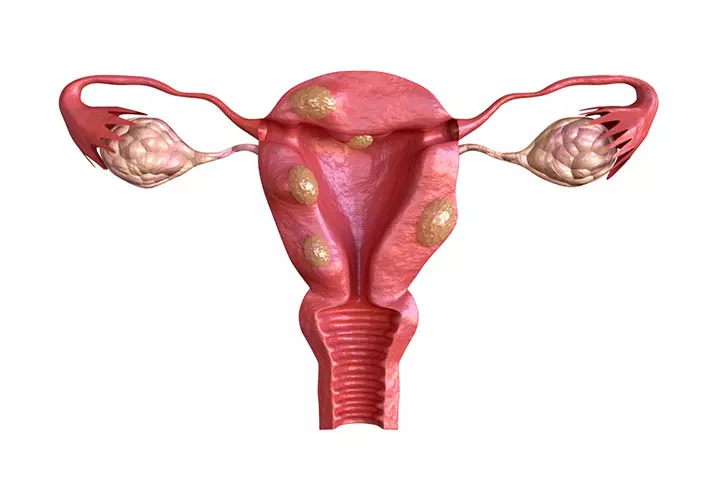
Image: Shutterstock
Uterine fibroids, also referred to as leiomyoma or myoma of the uterus, are non-cancerous tumors that grow abnormally in the uterine region. The good news is that in no way does fibroid tumor increase your chances of uterine cancer and it is not cancerous in any way. This is also known as myoma or leiomyoma. Let’s have a closer look here:
- It is a mass of fibrous tissue and compacted muscle that grows along the uterus wall.
- The tumor can be of the size of a pea or it may be as large as a grapefruit.
- Fibroid tumor is common among 50% to 80% of women.
- They usually develop after the commencement of the menstrual cycle.
Who Gets Fibroids?
Although there are no concrete factors proven to trigger a fibroid growth, below are some factors that make women susceptible to them. Fibroids are more common among:
- Women around 35 years of age.
- Women who are overweight or obese.
- Women who are not on contraceptive pills
During pregnancy too, there is a possibility to develop fibroid complications. If you are planning to conceive or are already pregnant.
Types Of Fibroids During Pregnancy

Image: Shutterstock
There are different kinds of fibroids based on the location where they sprout from in the uterine region:
1. Intramural fibroids
These fibroids are the most common types that grow within the muscle wall of the uterus. Intramural fibroids tend to grow large in size, making the uterus full.
2. Submucosal fibroids
These fibroids grow under the inner lining of the uterus known as endometrial lining.
They cause heavy and painful periods along with fertility problems.
 Research finds
Research finds3. Subserosal fibroids
These fibroids grow on the outside of the uterus, stretching into the pelvis.
- Subserosal fibroids may put additional strain on the bladder or bowel.
- Both submucosal and subserosal fibroids may grow from a stalk-like structure, thus getting the name pedunculated fibroid.
4. Cervical fibroids
As the name suggests, these fibroids grow in the neck of your cervix.
Uterine Fibroids During Pregnancy Symptoms
It is very important that you stay aware of the signs and symptoms of uterine fibrosis in pregnancy, so that you do not confuse it to be something else. Have a look here:
- You may feel the urge to urinate frequently
- Feel pressure on your pelvis
- Pain in the back
- Pain in legs
- Abdominal pains
- Vaginal bleeding
- Cramping
- Pain while urinating
- Fullness of abdomen that causes extra pressure and constipation
- Frequent unexplained miscarriages
Always report any vaginal bleeding and abdominal pain during pregnancy to your doctor to prevent any potential complications.
Diagnosis For Uterine Fibroids
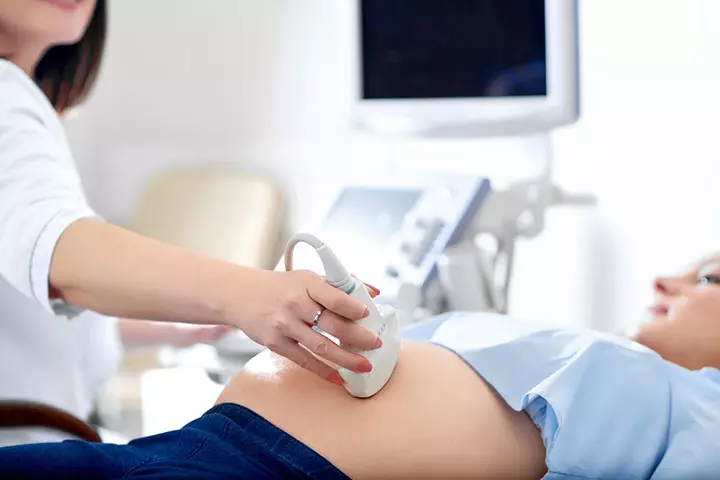
Image: Shutterstock
Once your doctor is informed about the above symptoms, he or she will diagnose the presence of fibroids with the below tests:
- An ultrasound scan to examine the inside of your uterus
- An obstetrics and gynecology specialist will check for the presence of any lumpy structures or abnormality in the shape of your uterus.
Uterine Fibroids And Pregnancy Complications
Fibroids generally develop before pregnancy. In many cases women remain unaware of the presence of the tumor until they get an ultrasound done.
- You can also detect the tumor with a pelvic exam. Also, watch out for the above mentioned symptoms.
- When you know about your fibroids beforehand, you can ask your doctor about the probable complications in your pregnancy.
- These are non-cancerous developments that generally do not interfere with your pregnancy.
- Around 30% of the women face complications in pregnancy such as abdominal pains along with vaginal bleeding.
- Unless your bleeding is substantial, your baby will be rarely affected.
- Submucosal fibroids directly affect the ability to conceive as they distort the entire uterus, thereby disturbing the implantation of the embryo even after fertilization.
- The sooner you try to conceive, the lesser the chances of infertility due to fibroids or even the occurrence of the fibroids.
Brittany Hyden, a mother to a lovely boy, reflects on the challenges she faced during her pregnancy, primarily caused by uterine fibroids. She shares, “I experienced horrible cramping around 12 weeks … For the first few days, I just went with it. Then, it got worse. Like, so much worse. I could barely move! So we went to urgent care to get looked at (since it was the weekend and I didn’t have a doctor in the new town we were living in).
“Turns out, the fibroid, which had grown from 4 cm to 8 cm, was “degenerating,” meaning it was fighting the growing baby for blood supply, and the fibroid was losing. The baby was okay, but the doctor was concerned about how large the fibroid was. I was so anxious to get to the real OB… After my first visit with the new OB, she suggested monthly anatomy scans to watch the fibroid. By 4 months, it had grown to 10cm, the size of a grapefruit. It was positioned right above my pubic bone and above my bladder. My doctor started calling it the baby’s twin… After the 10 cm measurement around 4 months, it did not grow anymore (YAYAYAY!)… (i).” Hyden ended up delivering a healthy baby vaginally.
 Research finds
Research finds- If your doctor feels that the presence of a fibroid is affecting your plans to conceive, he or she may recommend you to try conceiving for up to two more years.
- If you are over 34, chances of conceiving become lower. This is the instance where your doctor will recommend treating the fibroid through any of the above options except UAE.
 Things to know
Things to knowUterine Fibroids And The Effect On Your Baby

Image: Shutterstock
Well, most probably your baby will not be affected in any way by the uterine fibroids. Let’s take a closer look here:
- Even though there are no such huge risk factors involved, the chances of premature delivery or miscarriage may be slightly high in this case.
- Your baby may be in an abnormal position at times during pregnancy.
- The fibroids can stall labor or may even block the passage if located near the opening of the cervix.
- These are rare problems that might increase the chances of a cesarean section.
 Quick fact
Quick factManaging Fibroids During Pregnancy
Uterine fibroids are generally manageable, and adopting a healthy lifestyle can support your overall reproductive health. Consider the following tips (2):
- Drink plenty of water.
- Eat a balanced diet containing ample fruits and vegetables.
- Engage in regular, gentle exercise as recommended by your healthcare provider.
- Keep all prenatal appointments for ongoing monitoring.
Should Fibroids Be Treated?
The fibroids are not required to be removed unless they are seriously interfering with your routine, causing pain and discomfort.
- If you are already pregnant and the fibroids are fast growing inside, it is stated that pregnancy itself will minimize the growth.
- The more number of pregnancies you have, the lesser are the chances for the fibroids to develop.
Treatment During And After Pregnancy
If you are already in the vicious trap of symptoms such as heavy menstrual bleeding, pain and difficulty in conceiving, you can ask your doctor to explain to you the different treatments that are available for fibroids.
The final call will be taken by your health care provider looking at the seriousness of the condition. The main forms of fibroid during pregnancy treatment available are as below:
1. Hormone-balancing Drugs

Image: Shutterstock
Uterine fibroids are responsive to both estrogen and progesterone. Drugs that release a hormone called gonadotrophiniHormones that work in the ovaries of a woman and the testes of a man and help in the maturation and functioning of the sex glands. may be prescribed. This hormone acts like a counteroffensive to your estrogen levels, reducing the production and thereby limiting the possibility of more fibroids growing.
- Gonadotrophin-based drugs also help in shrinking the size of the existing fibroids.
- These drugs, also known as GnRHas are either prescribed in the form of injection, nasal spray, or implants that are placed under your skin.
- GnRHas drugs have heavy side effects that result in hot flashes, dry vagina and weaker bones. Hence these are given over a long stretch of 3 to 6 months.
2. Myomectomy
This is a surgical procedure that is used to remove the fibroids via operation. During this procedure, surgery is performed with the help of laparoscopyiA surgical technique that enables a surgeon to reach the belly and pelvis from the inside through a small incision. or hysteroscopyiA procedure used to examine and treat the uterus for any abnormality through a tube called a hysteroscope. .
- The recovery time from a myomectomy largely depends on the size of the fibroids removed.
- For larger fibroids, the period to recover is quite long and you will be recommended a strict bed rest for many days.
- Myomectomy is highly useful for women who are seriously planning to conceive and have children. However, there is no guarantee that fibroids will not grow back again.
3. Endometrial resection or ablation
An endometrial resection or ablation is a non surgical process. This procedure is largely used for the treatment of submucosal fibroids that grow in the inner lining of the uterus.
- During this process, the endometrial tissue from the inner lining is surgically removed, in the area where the fibroid is growing.
- After the completion of treatment, women can try conceiving again.
4. Myolysis
Myolysis is a procedure that is carried out with a keyhole surgery using a laparoscope or hysteroscope.
- A sonogram or MRI is then used to detect the exact position of the fibroid.
- The surgeon will then insert a needle probe or electric current into the fibroid to cauterise both the fibroid and the surrounding blood vessels.
5. Uterine artery embolisation (UAE)
This process is performed by an experienced radiologist, who will use the magnetic resonance imaging (MRI) scan to detect the location of the fibroid.
- The MRI will also show a clearer view of all the blood vessels surrounding the fibroid.
- The radiologist will then inject a plastic plug into the blood vessel to cut off the blood supply to the growing fibroid.
- This is an effective procedure where fibroids are shrunk completely. This procedure also cannot guarantee that fibroids will never return again.
- Most women may have to repeat the procedure after a few years once there is another onset.
- Unlike myomectomy or endometrial resection, UAE does not guarantee whether women who undergo the process will conceive again.
In most of the cases, fibroids are nothing more than pain in the belly. Thus, there is no need to worry unless the symptoms are causing too much problem in your pregnancy.
Tips And Caution
Your doctor will mostly put you on bed rest and medications for uterine fibroids while pregnant.
- Also, you will constantly check throughout your pregnancy, via ultrasound, to see how the fibroids present themselves from time to time.
- A necessary course of action will be taken by your doctor if he or she feels that there is an immediate threat to maternal health or pregnancy because of the fibroid.
- It is indeed an uncomfortable condition to have, but do not worry – there are many options available to treat fibroids. We hope this article has given you the info on such options and makes your decision a little easier.
Given its benign nature, uterine fibroids during pregnancy may not be an alarming threat to you and your baby. However, there still remains a minor chance of miscarriage, preterm delivery, or abnormal baby positioning. Therefore it is important to be aware of the symptoms in order for you to seek timely treatment and prevent such complications. In addition, you must discuss such complications and their risk factors with your ob/gyn to try and prevent them and have a healthy pregnancy.
Infographic: Types Of Uterine Fibroids And Their Symptoms
Uterine fibroids are common in women of reproductive age and menopause; however, they may also occur during pregnancy. But knowing the symptoms and the type of uterine fibroids can help you seek timely treatment. The infographic below includes information on different types of uterine fibroids and their symptoms you should be aware of.
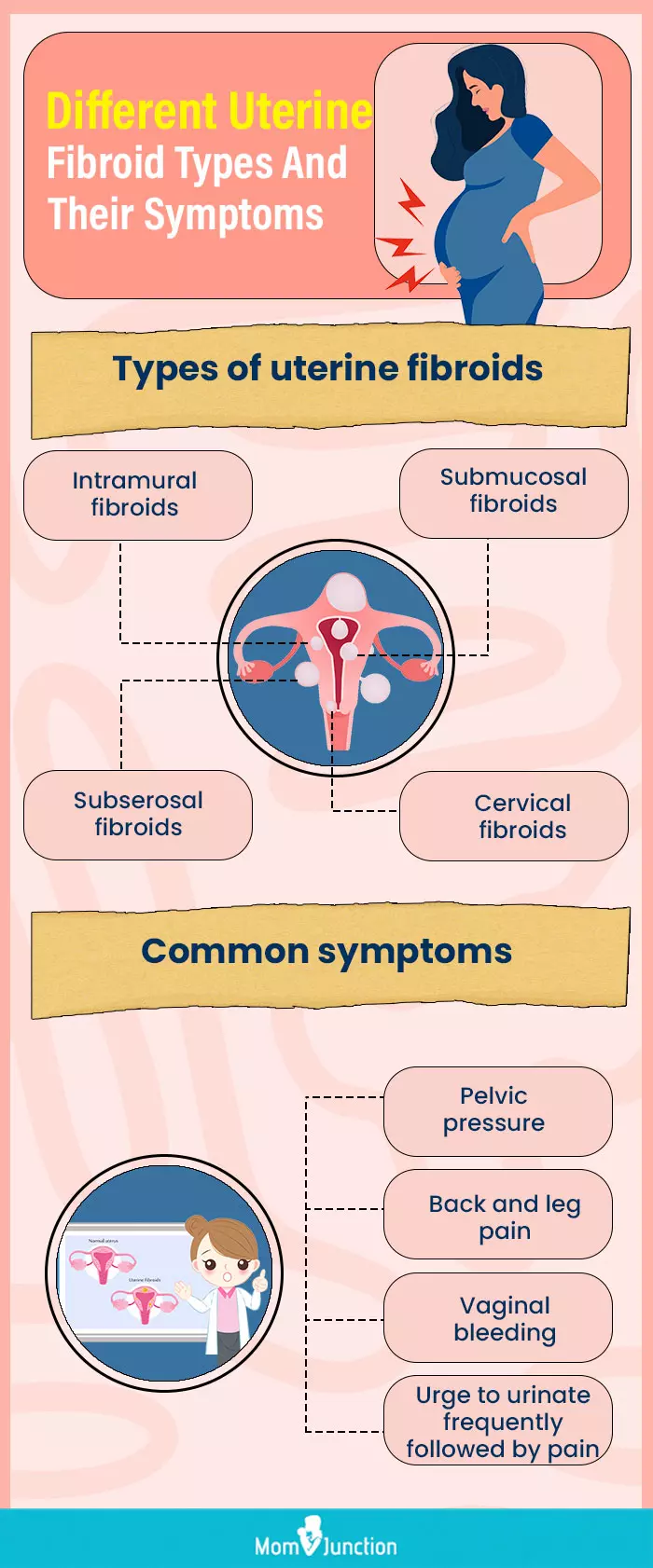
Illustration: Momjunction Design Team
Frequently Asked Questions
1. Can I have a normal delivery with fibroids?
Vaginal delivery is often possible with fibroids and is preferable to avoid risks associated with C-sections (1). In some rare cases, there may be an increased likelihood of pre-term delivery or delivery via C-section (3)
2. Do fibroids cause birth defects?
In some cases, fibroids may cause issues with the baby’s development (4).
3. What size fibroids affect pregnancy?
It is shown that fibroids over the size of three centimeters can increase your risk of experiencing complications during pregnancy (5).
4. How fast do fibroids grow during pregnancy?
There is a chance that fibroids could get much worse during the early weeks of pregnancy. A study found that the volume of the fibroids doubled between six to seven weeks of gestation (6).
5. Can a pregnant woman with fibroid take folic acid?
Yes, pregnant women with fibroids can take folic acid supplements because, to date, no studies suggest the association of folic acid with the increase in fibroids. On the other hand, folic acid is important during pregnancy for the healthy development of the baby’s brain and for preventing congenital abnormalities (7).
Illustration: Uterine Fibroids During Pregnancy: Symptoms And Treatment
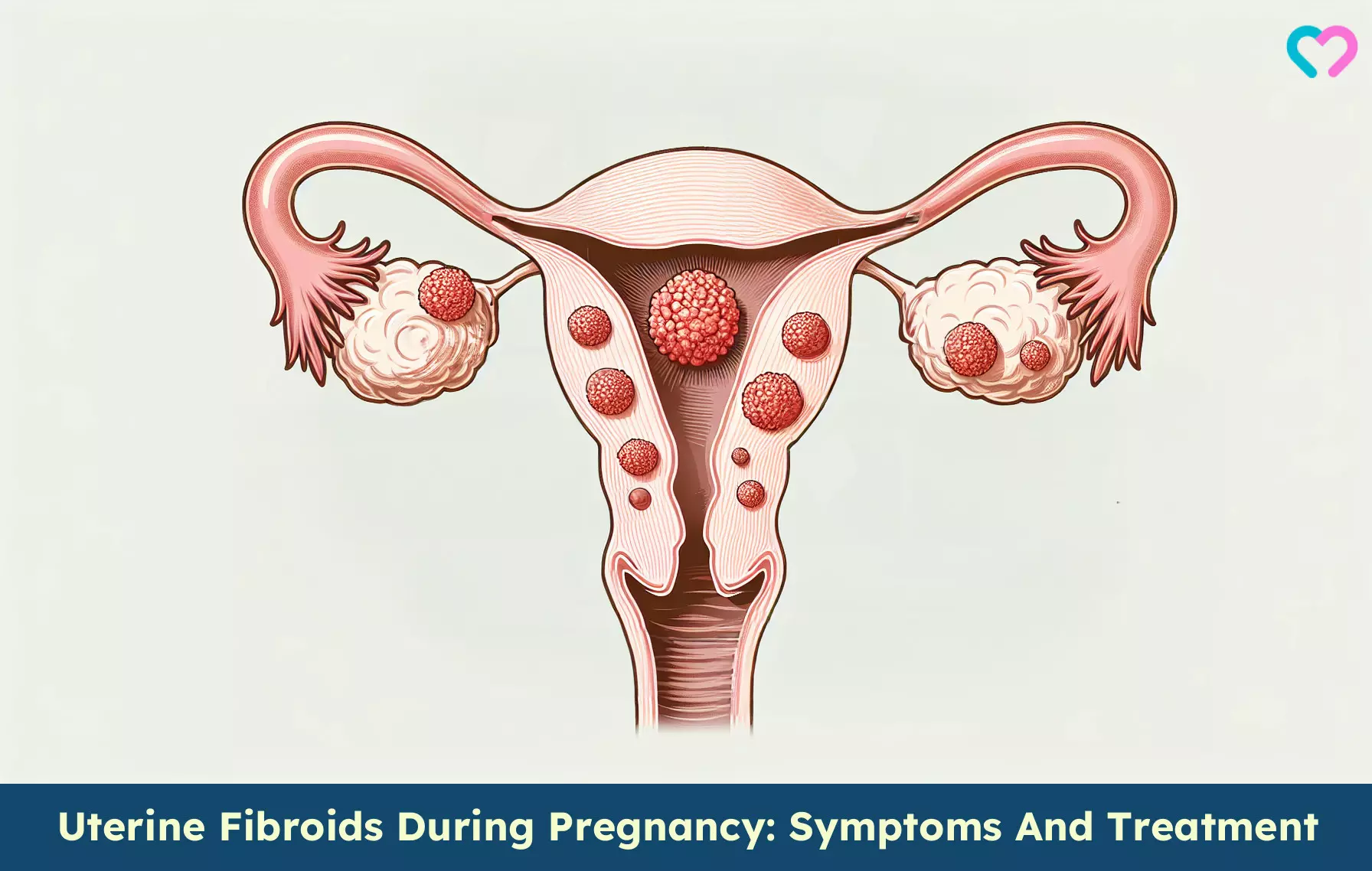
Image: Dall·E/MomJunction Design Team
Learn about the effects of fibroids on pregnancy, menopause, and natural remedies to help manage symptoms. Discover how to reduce the risk of complications and improve your quality of life.
Personal Experience: Source
MomJunction articles include first-hand experiences to provide you with better insights through real-life narratives. Here are the sources of personal accounts referenced in this article.
i. My high-risk pregnancy: Fibroids,https://mamahyden.wordpress.com/2021/10/15/my-high-risk-pregnancy-fibroids/
References
- Mihaela Camelia Tîrnovanu. Et al.; Uterine Fibroids and Pregnancy: A Review of the Challenges from a Romanian Tertiary Level Institution
https://www.ncbi.nlm.nih.gov/pmc/articles/PMC9141014/ - Hee Joong Lee, et al.; Contemporary Management of Fibroids in Pregnancy
https://www.ncbi.nlm.nih.gov/pmc/articles/PMC2876319/#B4 - Can uterine fibroids harm my pregnancy?
https://utswmed.org/medblog/fibroids-options-pregnancy/#:~:text=While%20there%20is%20a%20large - Uterine Fibroids.
https://my.clevelandclinic.org/health/diseases/9130-uterine-fibroids - Xiaoxiao Catherine Guo and James H. Segars; (2013); The Impact and Management of Fibroids for Fertility: an evidence-based approach.
https://www.ncbi.nlm.nih.gov/pmc/articles/PMC3608270/ - Laura Benaglia et al.; (2014); The Rapid Growth of Fibroids during Early Pregnancy.
https://www.ncbi.nlm.nih.gov/pmc/articles/PMC3896432/ - About Folic Acid.
https://www.cdc.gov/folic-acid/about/?CDC_AAref_Val=https://www.cdc.gov/ncbddd/folicacid/about.html - Juan Luis Giraldo Moreno and Susana Salazar López; Fibroids and Infertility
https://www.intechopen.com/chapters/77438
Community Experiences
Join the conversation and become a part of our nurturing community! Share your stories, experiences, and insights to connect with fellow parents.
Read full bio of Dr. Surakshith Battina
Read full bio of Rebecca Malachi
Read full bio of Swati Patwal
Read full bio of Dr. Joyani Das






